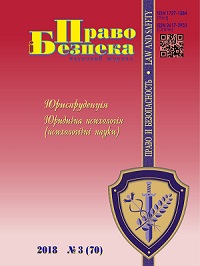Counteraction to sabotage measures on ammunition depots in the context of hybrid warfare
DOI:
https://doi.org/10.32631/pb.2018.3.02Keywords:
act of sabotage, military objects, hybrid warfare, ammunition depots, national securityAbstract
The state of the military sector is one of the most important indicators of the state’s development, it also determines the level of influence of the country on the economic and political situation that is taking place on the international scene. Ensuring the proper state of Ukraine’s national security is accompanied not only by the mentioned factors, but also by the fact that our state is in a military conflict with the Russian Federation. The article is focused on studying the issues related to the nature of the modern hybrid warfare in Ukraine, an act of sabotage was considered as one of the ways of such a war, it analyzed the acts of sabotage, the object of which is ammunition depots placed on the territory of Ukraine. The suggestions for improving and refining the system of counteraction to acts of sabotage are provided.
The topic of the study is relevant, therefore, it requires detailed consideration and study of the hybrid warfare’s nature, which combines not only conventional combat operations, but also political, economic, information, cybernetic means of combating the enemy. In the context of the military conflict, where Ukraine is located, the issue of counteracting and combating actions of sabotage, which is understood as an act aimed at weakening the state of explosions, arson, or other actions aimed at mass destruction of people, causing bodily harm or other harm to their health, destruction or damage of objects that have an important national or defense significance, etc. In our study, particular attention is paid to such objects as stockpiles of ammunition, where weapons, missiles, ammunition, explosives, firearms, special means are stored.
The authors of the article offer the main ways of improving and reforming the security system of these objects. The highlighted problems and suggested ways for their solution can become the fundamental basis for the development of a new security strategy.
Downloads
References
Seredenko M.M. and Yefimov H.V., 2014. Views on the forms and methods of using the constituent structures of the security and defense sector of the state during joint operations in different conditions of the military-political situation [Pohliady na formy i sposoby zastosuvannia skladovykh struktur sektoru bezpeky i oborony derzhavy pid chas spiklykh dii v riznykh umovakh voienno-politychnoi obstanovky]. Collection of scientific papers of the Military Academy, Odessa – Zbìrnik naukovih pracʹ Vìjsʹkovoï akademìï, No. 2, pp. 161-171. Available at http://nbuv.gov.ua/UJRN/zbnpva_2014_2_25 [Accessed 15 October 2018].
Kateshchenok A.V. and Neklonskyi I.M., 2017. Model of origin and distribution in case of fire sabotage carried out by initiating fire on an important element of the object without penetration on its territory [Model protsesu vynyknennia i rozpovsiudzhennia pozhezhi u razi dyversii, shcho zdiisniuiutsia shliakhom initsiiuvannia pozhezh na vazhlyvykh elementakh obiekta bez pronyknennia na yoho terytoriiu]. Information Processing Systems – Sistemi obrobki ìnformacìï, [online] Vol. 149, No. 3, pp. 164-168. https://doi.org/10.30748/soi.2017.149.32.
Puyvelde D. Van, 2015. Hybrid war – does it even exist? [Hibrydna viina – chy vona vzahali isnuie?]. NATO Review, [online]. Available at https://www.nato.int/docu/review/2015/Also-in-2015/hybrid-modern-future-warfare-russia-ukraine/UK/index.htm [Accessed 16 October 2018].
Herasina L.M., Pohribna V.L. and Polishchuk I.O. (compositors), 2015. Politological encyclopedic dictionary [Politolohichnyi entsyklopedychnyi slovnyk], Kharkiv: Pravo. P. 816. (Ed: Trebin M.P.).
Popovych K.V., 2016. Hybrid war as a modern method of warfare: historical and contemporary dimensions [Hibrydna viina yak suchasnyi sposib vedennia viiny: istorychnyi ta suchasnyi vymiry]. Scientific herald of Uzhhorod University. Series: History [Naukovyi visnyk Uzhhorodskoho Universytetu. Seriia “Istoriia”], Vol. 35, Iss. 2, pp. 75-79. Available at http://nbuv.gov.ua/UJRN/Nvuuist_2016_2_13 [Accessed 16 October 2018].
Dubov D.V., Barovska A.V, Isakova T.O., Koval I.O and Horbulin V.P., 2017. “Active measures” of USSR against USA: preface to hybrid war. Analytical report [“Aktyvni zakhody” SRSR proty SShA: proloh do hibrydnoi viiny]. 2nd ed. Kyiv: NISD. Available at http://www.niss.gov.ua/content/articles/files/Aktivny_Zahody-Print_Bleed=5mm-4f2c3.pdf [Accessed 17 October 2018].
Sulc L.B., 2010. Active measures, quiet war and two socialist revolutions. Washington, D.C.: The Nathan Hale Institute. Available at https://www.cia.gov/library/readingroom/docs/CIA-RDP90-00806R000200720008-2.pdf [Accessed 16 October 2018].
Kot K. and Matiukhina N., 2017. Armament depots in ukraine: history of explosions, fire situations and victims [Sklady zbroi v Ukraini: istoriia vybukhiv, pozhezh i zhertv]. BBC News. Ukraine, [online]. Available at https://www.bbc.com/ukrainian/features-41414138 [Accessed 16 October 2018].
Torop O. and Shramovych V., 2018. Poltorak: There are still people in the army who perceive Russia as a brother [Poltorak: v armii dosi ye liudy, yaki vvazhaiut Rosiiu bratom]. BBC News. Ukraine, [online]. Available at https://www.bbc.com/ukrainian/features-43851256 [Accessed 16 October 2018].
Prokopenko O., 2018. Arsenal of Weapons Will Be Guarded by a New Division [Arsenaly zbroi okhoroniatyme novyi pidrozdil]. Government courier – Urâdovij kur'êr. Available at: https://ukurier.gov.ua/uk/articles/arsenali-zbroyi-ohoronyatime-novij-pidrozdil/ [Accessed 16 October 2018].
Karmannyi Ye.V. and Lys M.V., 2018. Organizational and Legal Issues of Improvement of the Logistics System of Military Forces Munitions in the Context of Opposition to Modern Sovereign Measures [Orhanizatsiino-pravovi pytannia udoskonalennia systemy tylovoho zabezpechennia boieprypasamy viiskovykh formuvan u konteksti protydii suchasnym dyversiinym zakhodam]. In: National Academy of the National Guard of Ukraine, Topical issues of service and military activity of military formations and law enforcement agencies [Aktualni pytannia zabezpechennia sluzhbovo-boiovoi diialnosti viiskovykh formuvan ta pravookhoronnykh orhaniv]. October 31, 2018, Kharkiv. Kharkiv: NANGU.



